Gennaro Cuofano's Blog, page 95
September 9, 2022
IKEA Effect And Why It Matters In Business
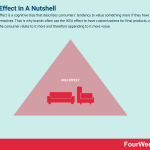

The IKEA effect is a cognitive bias that describes consumers’ tendency to value something more if they have made it themselves. That is why brands often use the IKEA effect to have customizations for final products, as they help the consumer relate to it more and therefore appending to it more value.
Understanding the IKEA effectThe IKEA effect is named after Swedish furniture giant IKEA and their range of iconic flat-pack furniture and home décor.
But the effect itself has been used in marketing consumer goods since at least the early 1950s. During that time, Betty Crocker instant cake mixes began to appear on supermarket shelves. Consumers were initially wary of these products, believing that it made the process of making a cake too simplistic.
Upon this realization, Betty Crocker changed the recipe so that consumers had to add an egg. This simple change in the process meant that consumers felt they had contributed some effort to the final product. Some 70 years later, cake mixes are as popular as ever.
Implications of the IKEA effect for business and marketingTo harness the benefits of the IKEA effect, businesses should keep these principles in mind:
Consumers are often willing to pay more for a product if it means that there is some assembly required, creating a win-win scenario. Businesses save money on marketing and assembly costs, thereby increasing profit margins. Consumers do most of the assembly work, feel more empowered, and believe they received a good deal as a result.Businesses that sell products such as Lego which facilitate personal expression will benefit the most. But the IKEA effect is nonetheless significant in less-customizable products. For example, some clothing companies are now selling made-to-measure attire by allowing consumers to become more involved in the tailoring process. Value is derived from self-efficacy, which is a person’s belief in their ability to succeed in a given situation. It is therefore prudent for businesses to find a balance between value and effort. Returning to the cake mix example, we saw that consumers equated too little effort with product value. However, a product that requires too much effort reduces self-efficacy and is also likely to be judged as low value.Potential disadvantages of the IKEA effectIn the software development industry, the IKEA effect can cause developers to become overly attached to their creations and become sensitive to criticism. Ultimately, software development companies can become myopic toward product development and marketing, hindering growth, and innovation.
For certain businesses or industries, the IKEA effect may simply be unsuitable. Large companies such as McDonald’s would become inefficient during peak periods if meals could be customized ad nauseam.
The same can also be said for logistics. DELL is a terrific example of a company adding customization to a generic product line by allowing customers to “build” their PCs. However, few businesses could absorb the logistical inefficiencies associated with this level of consumer involvement in the manufacturing process.
Key takeawaysThe IKEA effect describes the tendency for consumers to place more value on something they have created themselves.The IKEA effect has significant benefits for businesses who can charge more for products that require some degree of consumer involvement. Both factors contribute to increased profit margins.The IKEA effect can cause myopic business practices in the software industry. Furthermore, it will not be suitable for large organizations that place a high value on efficiency during periods of high demand.Connected Business Concepts As highlighted by German psychologist Gerd Gigerenzer in the paper “Heuristic Decision Making,” the term heuristic is of Greek origin, meaning “serving to find out or discover.” More precisely, a heuristic is a fast and accurate way to make decisions in the real world, which is driven by uncertainty.
As highlighted by German psychologist Gerd Gigerenzer in the paper “Heuristic Decision Making,” the term heuristic is of Greek origin, meaning “serving to find out or discover.” More precisely, a heuristic is a fast and accurate way to make decisions in the real world, which is driven by uncertainty. Bounded rationality is a concept attributed to Herbert Simon, an economist and political scientist interested in decision-making and how we make decisions in the real world. In fact, he believed that rather than optimizing (which was the mainstream view in the past decades) humans follow what he called satisficing.
Bounded rationality is a concept attributed to Herbert Simon, an economist and political scientist interested in decision-making and how we make decisions in the real world. In fact, he believed that rather than optimizing (which was the mainstream view in the past decades) humans follow what he called satisficing. Second-order thinking is a means of assessing the implications of our decisions by considering future consequences. Second-order thinking is a mental model that considers all future possibilities. It encourages individuals to think outside of the box so that they can prepare for every and eventuality. It also discourages the tendency for individuals to default to the most obvious choice.
Second-order thinking is a means of assessing the implications of our decisions by considering future consequences. Second-order thinking is a mental model that considers all future possibilities. It encourages individuals to think outside of the box so that they can prepare for every and eventuality. It also discourages the tendency for individuals to default to the most obvious choice.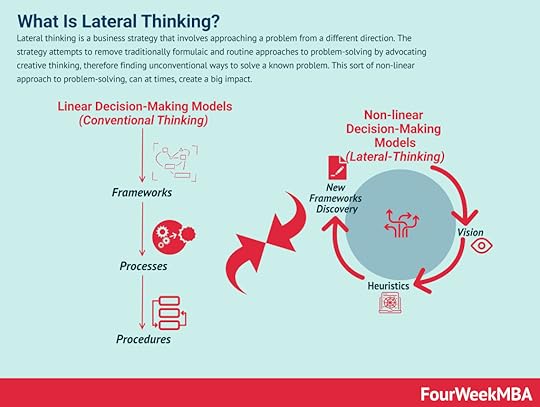 Lateral thinking is a business strategy that involves approaching a problem from a different direction. The strategy attempts to remove traditionally formulaic and routine approaches to problem-solving by advocating creative thinking, therefore finding unconventional ways to solve a known problem. This sort of non-linear approach to problem-solving, can at times, create a big impact.
Lateral thinking is a business strategy that involves approaching a problem from a different direction. The strategy attempts to remove traditionally formulaic and routine approaches to problem-solving by advocating creative thinking, therefore finding unconventional ways to solve a known problem. This sort of non-linear approach to problem-solving, can at times, create a big impact. Moonshot thinking is an approach to innovation, and it can be applied to business or any other discipline where you target at least 10X goals. That shifts the mindset, and it empowers a team of people to look for unconventional solutions, thus starting from first principles, by leveraging on fast-paced experimentation.
Moonshot thinking is an approach to innovation, and it can be applied to business or any other discipline where you target at least 10X goals. That shifts the mindset, and it empowers a team of people to look for unconventional solutions, thus starting from first principles, by leveraging on fast-paced experimentation. The concept of cognitive biases was introduced and popularized by the work of Amos Tversky and Daniel Kahneman in 1972. Biases are seen as systematic errors and flaws that make humans deviate from the standards of rationality, thus making us inept at making good decisions under uncertainty.
The concept of cognitive biases was introduced and popularized by the work of Amos Tversky and Daniel Kahneman in 1972. Biases are seen as systematic errors and flaws that make humans deviate from the standards of rationality, thus making us inept at making good decisions under uncertainty. The Dunning-Kruger effect describes a cognitive bias where people with low ability in a task overestimate their ability to perform that task well. Consumers or businesses that do not possess the requisite knowledge make bad decisions. What’s more, knowledge gaps prevent the person or business from seeing their mistakes.
The Dunning-Kruger effect describes a cognitive bias where people with low ability in a task overestimate their ability to perform that task well. Consumers or businesses that do not possess the requisite knowledge make bad decisions. What’s more, knowledge gaps prevent the person or business from seeing their mistakes. Occam’s Razor states that one should not increase (beyond reason) the number of entities required to explain anything. All things being equal, the simplest solution is often the best one. The principle is attributed to 14th-century English theologian William of Ockham.
Occam’s Razor states that one should not increase (beyond reason) the number of entities required to explain anything. All things being equal, the simplest solution is often the best one. The principle is attributed to 14th-century English theologian William of Ockham. The Mandela effect is a phenomenon where a large group of people remembers an event differently from how it occurred. The Mandela effect was first described in relation to Fiona Broome, who believed that former South African President Nelson Mandela died in prison during the 1980s. While Mandela was released from prison in 1990 and died 23 years later, Broome remembered news coverage of his death in prison and even a speech from his widow. Of course, neither event occurred in reality. But Broome was later to discover that she was not the only one with the same recollection of events.
The Mandela effect is a phenomenon where a large group of people remembers an event differently from how it occurred. The Mandela effect was first described in relation to Fiona Broome, who believed that former South African President Nelson Mandela died in prison during the 1980s. While Mandela was released from prison in 1990 and died 23 years later, Broome remembered news coverage of his death in prison and even a speech from his widow. Of course, neither event occurred in reality. But Broome was later to discover that she was not the only one with the same recollection of events. The crowding-out effect occurs when public sector spending reduces spending in the private sector.
The crowding-out effect occurs when public sector spending reduces spending in the private sector. The bandwagon effect tells us that the more a belief or idea has been adopted by more people within a group, the more the individual adoption of that idea might increase within the same group. This is the psychological effect that leads to herd mentality. What is marketing can be associated with social proof.
The bandwagon effect tells us that the more a belief or idea has been adopted by more people within a group, the more the individual adoption of that idea might increase within the same group. This is the psychological effect that leads to herd mentality. What is marketing can be associated with social proof.Read Next: Biases, Bounded Rationality, Mandela Effect, Dunning-Kruger Effect, Lindy Effect, Crowding Out Effect, Bandwagon Effect.
Main Guides:
Business ModelsBusiness StrategyMarketing StrategyBusiness Model InnovationPlatform Business ModelsNetwork Effects In A NutshellDigital Business ModelsThe post IKEA Effect And Why It Matters In Business appeared first on FourWeekMBA.
Continuous Integration/Continuous Deployment In A Nutshell
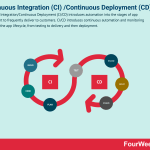

Continuous Integration/Continuous Deployment (CI/CD) introduces automation into the stages of app development to frequently deliver to customers. CI/CD introduces continuous automation and monitoring throughout the app lifecycle, from testing to delivery and then deployment.
Understanding Continuous Integration/Continuous DeploymentAs the notion of software development continues to expand, many adjacent facets of the software development process have become prime targets for code takeover. Examples of these targets include integration and deployment, which form the basis of CI/CD.
CI/CD introduces continuous automation and monitoring throughout the app lifecycle, from testing to delivery and then deployment. Automation during script execution reduces the likelihood of introducing errors and as a result, requires less human intervention.
Furthermore, code changes are continually built, tested, and deployed at every iteration to lessen the chances that code is based on bugs or previous failed versions.
The CI/CD pipelineCollectively, these practices are referred to as a “CI/CD pipeline” and are supported by agile approaches such as DevOps or Site Reliability Engineering (SRE). This pipeline has several benefits for business, including:
The ability to reduce costs and complexities and divert resources to areas that will give the best return on investment. Ultimately, the CI/CD pipeline accurately balances project resources in the context of project constraints.Improved reliability. CI/CD pipelines manage the complexity of software integration where the work of multiple developers must be combined. This is achieved using the Continuous Integration Certification Test. The test is comprised of three components: daily commits to the main branch, automated triggering of build and test, and repair from any failed build within ten minutes.Making the team more attractive to developers. The chances of attracting skilled talent can be increased by implementing the CI/CD pipeline, which automatically allows teams to meet 25% of the items on the Joel Test. This gives the impression of a high-functioning, professional team.The two components of the CI/CD approachThere are two core components to the CI/CD approach. Although closely related, each component should be incorporated by the business for maximum effect.
Here is a look at each:
Continuous integration. Automation is an integral part of an effective development workflow and gives project teams the time to focus on what is important. Indeed, every task that can be automated should be automated. Testing is one such process. They should verify that the steps a customer will take through a system are working – irrespective of any changes made. This gives team members the confidence to experiment, incorporate new features, detect problems early, and deliver quickly.Continuous deployment. Essentially, continuous deployment is the release of every good build that passes automated tests into production. This requires an ability to get new features, configuration changes, and bug fixes into production. Importantly, it must be achieved safely, sustainably, and quickly by ensuring that code is always in a deployable state. This state must be maintained in the face of many developers making hundreds or even thousands of changes daily.Differences between core component terms and phrasingMany practitioners use continuous deployment interchangeably with another term: continuous delivery.
However, there is a difference in meaning between each term. As we have discussed, continuous deployment concerns the automation of the release of a good build to the production environment. Some prefer to call this component “continuous release” for this reason.
Continuous delivery, on the other hand, seeks to ensure that every good build is potentially ready for production release. Ideally, this means that the build is subject to user acceptance tests.
Key takeawaysContinuous Integration/Continuous Deployment introduces automation into the software development process to help businesses remain competitive.Continuous Integration/Continuous Deployment practices are collectively known as the CI/CD pipeline, which is supported by agile approaches such as DevOps.Continuous Integration/Continuous Deployment is based on the two core components of continuous integration and continuous deployment. Both work together to ensure that automation – which should be introduced wherever possible – is present in nearly every facet of the product lifecycle.Related Agile Business Frameworks AIOps is the application of artificial intelligence to IT operations. It has become particularly useful for modern IT management in hybridized, distributed, and dynamic environments. AIOps has become a key operational component of modern digital-based organizations, built around software and algorithms.
AIOps is the application of artificial intelligence to IT operations. It has become particularly useful for modern IT management in hybridized, distributed, and dynamic environments. AIOps has become a key operational component of modern digital-based organizations, built around software and algorithms.  Agile started as a lightweight development method compared to heavyweight software development, which is the core paradigm of the previous decades of software development. By 2001 the Manifesto for Agile Software Development was born as a set of principles that defined the new paradigm for software development as a continuous iteration. This would also influence the way of doing business.
Agile started as a lightweight development method compared to heavyweight software development, which is the core paradigm of the previous decades of software development. By 2001 the Manifesto for Agile Software Development was born as a set of principles that defined the new paradigm for software development as a continuous iteration. This would also influence the way of doing business.  Agile project management (APM) is a strategy that breaks large projects into smaller, more manageable tasks. In the APM methodology, each project is completed in small sections – often referred to as iterations. Each iteration is completed according to its project life cycle, beginning with the initial design and progressing to testing and then quality assurance.
Agile project management (APM) is a strategy that breaks large projects into smaller, more manageable tasks. In the APM methodology, each project is completed in small sections – often referred to as iterations. Each iteration is completed according to its project life cycle, beginning with the initial design and progressing to testing and then quality assurance.  Agile Modeling (AM) is a methodology for modeling and documenting software-based systems. Agile Modeling is critical to the rapid and continuous delivery of software. It is a collection of values, principles, and practices that guide effective, lightweight software modeling.
Agile Modeling (AM) is a methodology for modeling and documenting software-based systems. Agile Modeling is critical to the rapid and continuous delivery of software. It is a collection of values, principles, and practices that guide effective, lightweight software modeling. Agile Business Analysis (AgileBA) is certification in the form of guidance and training for business analysts seeking to work in agile environments. To support this shift, AgileBA also helps the business analyst relate Agile projects to a wider organizational mission or strategy. To ensure that analysts have the necessary skills and expertise, AgileBA certification was developed.
Agile Business Analysis (AgileBA) is certification in the form of guidance and training for business analysts seeking to work in agile environments. To support this shift, AgileBA also helps the business analyst relate Agile projects to a wider organizational mission or strategy. To ensure that analysts have the necessary skills and expertise, AgileBA certification was developed.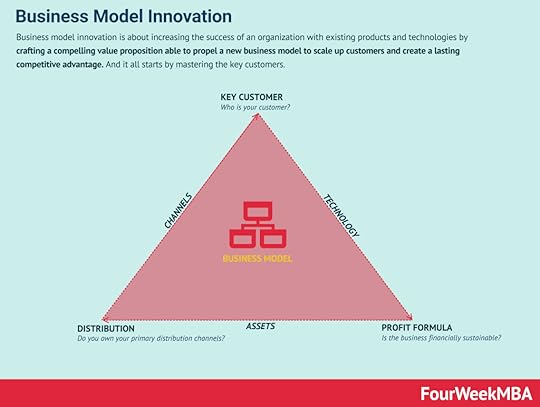 Business model innovation is about increasing the success of an organization with existing products and technologies by crafting a compelling value proposition able to propel a new business model to scale up customers and create a lasting competitive advantage. And it all starts by mastering the key customers.
Business model innovation is about increasing the success of an organization with existing products and technologies by crafting a compelling value proposition able to propel a new business model to scale up customers and create a lasting competitive advantage. And it all starts by mastering the key customers. That is a process that requires a continuous feedback loop to develop a valuable product and build a viable business model. Continuous innovation is a mindset where products and services are designed and delivered to tune them around the customers’ problem and not the technical solution of its founders.
That is a process that requires a continuous feedback loop to develop a valuable product and build a viable business model. Continuous innovation is a mindset where products and services are designed and delivered to tune them around the customers’ problem and not the technical solution of its founders. A design sprint is a proven five-day process where critical business questions are answered through speedy design and prototyping, focusing on the end-user. A design sprint starts with a weekly challenge that should finish with a prototype, test at the end, and therefore a lesson learned to be iterated.
A design sprint is a proven five-day process where critical business questions are answered through speedy design and prototyping, focusing on the end-user. A design sprint starts with a weekly challenge that should finish with a prototype, test at the end, and therefore a lesson learned to be iterated. 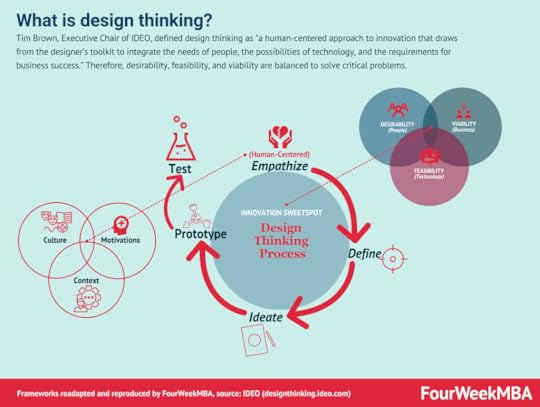 Tim Brown, Executive Chair of IDEO, defined design thinking as “a human-centered approach to innovation that draws from the designer’s toolkit to integrate the needs of people, the possibilities of technology, and the requirements for business success.” Therefore, desirability, feasibility, and viability are balanced to solve critical problems.
Tim Brown, Executive Chair of IDEO, defined design thinking as “a human-centered approach to innovation that draws from the designer’s toolkit to integrate the needs of people, the possibilities of technology, and the requirements for business success.” Therefore, desirability, feasibility, and viability are balanced to solve critical problems.  DevOps refers to a series of practices performed to perform automated software development processes. It is a conjugation of the term “development” and “operations” to emphasize how functions integrate across IT teams. DevOps strategies promote seamless building, testing, and deployment of products. It aims to bridge a gap between development and operations teams to streamline the development altogether.
DevOps refers to a series of practices performed to perform automated software development processes. It is a conjugation of the term “development” and “operations” to emphasize how functions integrate across IT teams. DevOps strategies promote seamless building, testing, and deployment of products. It aims to bridge a gap between development and operations teams to streamline the development altogether. Product discovery is a critical part of agile methodologies, as its aim is to ensure that products customers love are built. Product discovery involves learning through a raft of methods, including design thinking, lean start-up, and A/B testing to name a few. Dual Track Agile is an agile methodology containing two separate tracks: the “discovery” track and the “delivery” track.
Product discovery is a critical part of agile methodologies, as its aim is to ensure that products customers love are built. Product discovery involves learning through a raft of methods, including design thinking, lean start-up, and A/B testing to name a few. Dual Track Agile is an agile methodology containing two separate tracks: the “discovery” track and the “delivery” track. Feature-Driven Development is a pragmatic software process that is client and architecture-centric. Feature-Driven Development (FDD) is an agile software development model that organizes workflow according to which features need to be developed next.
Feature-Driven Development is a pragmatic software process that is client and architecture-centric. Feature-Driven Development (FDD) is an agile software development model that organizes workflow according to which features need to be developed next. eXtreme Programming was developed in the late 1990s by Ken Beck, Ron Jeffries, and Ward Cunningham. During this time, the trio was working on the Chrysler Comprehensive Compensation System (C3) to help manage the company payroll system. eXtreme Programming (XP) is a software development methodology. It is designed to improve software quality and the ability of software to adapt to changing customer needs.
eXtreme Programming was developed in the late 1990s by Ken Beck, Ron Jeffries, and Ward Cunningham. During this time, the trio was working on the Chrysler Comprehensive Compensation System (C3) to help manage the company payroll system. eXtreme Programming (XP) is a software development methodology. It is designed to improve software quality and the ability of software to adapt to changing customer needs. The Agile methodology has been primarily thought of for software development (and other business disciplines have also adopted it). Lean thinking is a process improvement technique where teams prioritize the value streams to improve it continuously. Both methodologies look at the customer as the key driver to improvement and waste reduction. Both methodologies look at improvement as something continuous.
The Agile methodology has been primarily thought of for software development (and other business disciplines have also adopted it). Lean thinking is a process improvement technique where teams prioritize the value streams to improve it continuously. Both methodologies look at the customer as the key driver to improvement and waste reduction. Both methodologies look at improvement as something continuous.  A startup company is a high-tech business that tries to build a scalable business model in tech-driven industries. A startup company usually follows a lean methodology, where continuous innovation, driven by built-in viral loops is the rule. Thus, driving growth and building network effects as a consequence of this strategy.
A startup company is a high-tech business that tries to build a scalable business model in tech-driven industries. A startup company usually follows a lean methodology, where continuous innovation, driven by built-in viral loops is the rule. Thus, driving growth and building network effects as a consequence of this strategy.  Kanban is a lean manufacturing framework first developed by Toyota in the late 1940s. The Kanban framework is a means of visualizing work as it moves through identifying potential bottlenecks. It does that through a process called just-in-time (JIT) manufacturing to optimize engineering processes, speed up manufacturing products, and improve the go-to-market strategy.
Kanban is a lean manufacturing framework first developed by Toyota in the late 1940s. The Kanban framework is a means of visualizing work as it moves through identifying potential bottlenecks. It does that through a process called just-in-time (JIT) manufacturing to optimize engineering processes, speed up manufacturing products, and improve the go-to-market strategy.  RAD was first introduced by author and consultant James Martin in 1991. Martin recognized and then took advantage of the endless malleability of software in designing development models. Rapid Application Development (RAD) is a methodology focusing on delivering rapidly through continuous feedback and frequent iterations.
RAD was first introduced by author and consultant James Martin in 1991. Martin recognized and then took advantage of the endless malleability of software in designing development models. Rapid Application Development (RAD) is a methodology focusing on delivering rapidly through continuous feedback and frequent iterations.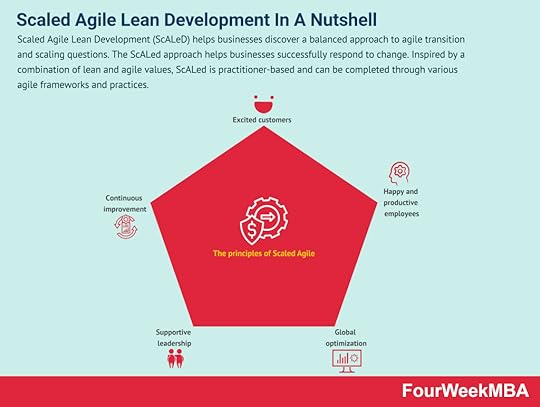 Scaled Agile Lean Development (ScALeD) helps businesses discover a balanced approach to agile transition and scaling questions. The ScALed approach helps businesses successfully respond to change. Inspired by a combination of lean and agile values, ScALed is practitioner-based and can be completed through various agile frameworks and practices.
Scaled Agile Lean Development (ScALeD) helps businesses discover a balanced approach to agile transition and scaling questions. The ScALed approach helps businesses successfully respond to change. Inspired by a combination of lean and agile values, ScALed is practitioner-based and can be completed through various agile frameworks and practices. The Spotify Model is an autonomous approach to scaling agile, focusing on culture communication, accountability, and quality. The Spotify model was first recognized in 2012 after Henrik Kniberg, and Anders Ivarsson released a white paper detailing how streaming company Spotify approached agility. Therefore, the Spotify model represents an evolution of agile.
The Spotify Model is an autonomous approach to scaling agile, focusing on culture communication, accountability, and quality. The Spotify model was first recognized in 2012 after Henrik Kniberg, and Anders Ivarsson released a white paper detailing how streaming company Spotify approached agility. Therefore, the Spotify model represents an evolution of agile.  As the name suggests, TDD is a test-driven technique for delivering high-quality software rapidly and sustainably. It is an iterative approach based on the idea that a failing test should be written before any code for a feature or function is written. Test-Driven Development (TDD) is an approach to software development that relies on very short development cycles.
As the name suggests, TDD is a test-driven technique for delivering high-quality software rapidly and sustainably. It is an iterative approach based on the idea that a failing test should be written before any code for a feature or function is written. Test-Driven Development (TDD) is an approach to software development that relies on very short development cycles.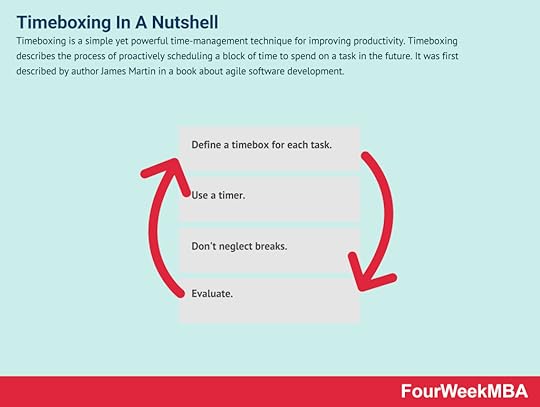 Timeboxing is a simple yet powerful time-management technique for improving productivity. Timeboxing describes the process of proactively scheduling a block of time to spend on a task in the future. It was first described by author James Martin in a book about agile software development.
Timeboxing is a simple yet powerful time-management technique for improving productivity. Timeboxing describes the process of proactively scheduling a block of time to spend on a task in the future. It was first described by author James Martin in a book about agile software development. Scrum is a methodology co-created by Ken Schwaber and Jeff Sutherland for effective team collaboration on complex products. Scrum was primarily thought for software development projects to deliver new software capability every 2-4 weeks. It is a sub-group of agile also used in project management to improve startups’ productivity.
Scrum is a methodology co-created by Ken Schwaber and Jeff Sutherland for effective team collaboration on complex products. Scrum was primarily thought for software development projects to deliver new software capability every 2-4 weeks. It is a sub-group of agile also used in project management to improve startups’ productivity. Scrum anti-patterns describe any attractive, easy-to-implement solution that ultimately makes a problem worse. Therefore, these are the practice not to follow to prevent issues from emerging. Some classic examples of scrum anti-patterns comprise absent product owners, pre-assigned tickets (making individuals work in isolation), and discounting retrospectives (where review meetings are not useful to really make improvements).
Scrum anti-patterns describe any attractive, easy-to-implement solution that ultimately makes a problem worse. Therefore, these are the practice not to follow to prevent issues from emerging. Some classic examples of scrum anti-patterns comprise absent product owners, pre-assigned tickets (making individuals work in isolation), and discounting retrospectives (where review meetings are not useful to really make improvements).  Scrum at Scale (Scrum@Scale) is a framework that Scrum teams use to address complex problems and deliver high-value products. Scrum at Scale was created through a joint venture between the Scrum Alliance and Scrum Inc. The joint venture was overseen by Jeff Sutherland, a co-creator of Scrum and one of the principal authors of the Agile Manifesto.
Scrum at Scale (Scrum@Scale) is a framework that Scrum teams use to address complex problems and deliver high-value products. Scrum at Scale was created through a joint venture between the Scrum Alliance and Scrum Inc. The joint venture was overseen by Jeff Sutherland, a co-creator of Scrum and one of the principal authors of the Agile Manifesto. Read Next: MVP, Lean Canvas, Scrum, Design Thinking, VTDF Framework.
Read More: Business Models
Read Next: Business Analysis, Competitor Analysis, Continuous Innovation, Agile Methodology, Lean Startup, Business Model
Read Next: Continuous Innovation, Agile Methodology, Lean Startup, Business Model Innovation.
Main Free Guides:
Business ModelsBusiness StrategyBusiness DevelopmentDigital Business ModelsDistribution ChannelsMarketing StrategyPlatform Business ModelsTech Business ModelThe post Continuous Integration/Continuous Deployment In A Nutshell appeared first on FourWeekMBA.
History of Snapchat
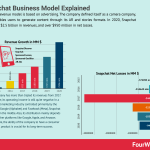
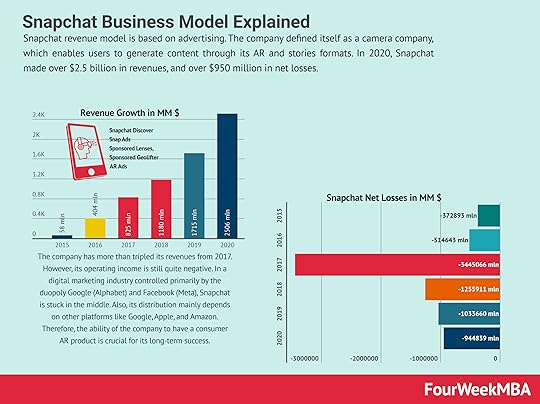
Snapchat was initially conceived by former Stanford University students Bobby Murphy, Reggie Brown, and Evan Spiegel.
The characteristic feature of Snapchat where pictures and messages are only available for a short time was the brainchild of Brown, who approached Spiegel with his idea because he had more business experience.
Today, the Snapchat app has more of a focus on chronological user stories and short-form content where businesses can promote their brands.
The app’s mostly younger audience of 332 million users sends around 4 billion so-called “snaps” every day with 101 different product features so far developed.
To see how Snapchat arrived at this point and managed to carve out a niche in the crowded social media space, let’s take a general look at the early days of the company.
Development at Stanford UniversityAs we touched on above, Snapchat was developed while Murphy, Brown, and Spiegel were students at Stanford University.
The story goes that Brown came up with the idea for a social media platform where users could post videos and photos that were erased a few moments after they were viewed.
Brown then got Spiegel involved and also Murphy who was tasked with writing the code for the app.
After working for a few months, an app known as Picaboo was launched in the App Store on July 8, 2011.
During this time, Brown created the company mascot known as “Ghostface Chillah” which still serves as Snapchat’s logo today.
Departure of BrownSoon after Snapchat was launched, Brown was ousted from the company for reasons which remain a mystery.
However, court documents reveal the three co-founders had a “contentious phone conversation” which resulted in Spiegel and Murphy changing the passwords for Snapchat’s accounts and servers.
Brown later sued the pair for breach of contract and settled for a total of $157.5 million split over two payments in 2014 and 2016. As part of the settlement, Snapchat released a statement attributing the idea for the company to Brown.
Introductory blog postSpiegel then made an introductory blog post on the Snapchat website espousing a new way of sharing information that one wanted to see disappear.
While the post is somewhat ironically no longer available, Spiegel described the app in terms of moments we can all relate to:
“Snapchat isn’t about capturing the traditional Kodak moment. It’s about communicating with the full range of human emotion – not just what appears to be pretty or perfect. Like when I think I’m good at imitating the face of a star-nosed mole, or if I want to show my friend the girl I have a crush on (it would be awkward if that got around), and when I’m away at college and miss my Mom…er…my friends.”
The idea of social media activity that would not come back to haunt users appealed to the younger generation in particular.
Video is addedVideo was added to Snapchat around a year after it was launched which coincided with the app’s release in the Google Play store.
While only ten seconds in length, videos helped propel the platform to around 50 million daily snaps.
The following year, developers added the “Stories” and “Chat” features with the former enabling users to post a sequence of snaps available for a maximum of 24 hours.
By 2015, there were 75 million active monthly users and advertising became an increasingly lucrative source of income.
In early 2017, Snapchat held an IPO on the New York Stock Exchange and achieved a valuation of $33 billion.
Key takeaways:Snapchat was initially conceived by former Stanford University students Bobby Murphy, Reggie Brown, and Evan Spiegel. Brown departed the company soon after the app was launched in 2011 for reasons that remain unclear.In an introductory blog post, Spiegel described the app in terms of moments that occur online that we’d rather not have preserved for posterity. This premise proved to be a hit with younger social media users.When video functionality was added at around the same time as the app became available for Android, Snapchat quickly reached 50 million daily snaps. Additional features and a 2017 IPO followed.Read Next: Snapchat Business Model
Read Also: Facebook Business Model, TikTok Business Model, Twitter Business Model.
The post History of Snapchat appeared first on FourWeekMBA.
Characteristics of Qualitative Research
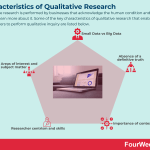

Qualitative research is performed by businesses that acknowledge the human condition and want to learn more about it. Some of the key characteristics of qualitative research that enable practitioners to perform qualitative inquiry comprise small data, absence of definitive truth, the importance of context, researcher’s skills and are of interests.
Absence of a definitive truthOne of the most obvious characteristics of qualitative research is the lack of definitive truth.
Unlike quantitative data, which is clinical, logical, and deals in absolutes, qualitative data is collected by researchers who simply want to know more about the subject at hand.
Note that qualitative data collection does not occur in a vacuum and is context-dependent.
Data are the result of various situational factors that vary from one person to the next, and it is for this reason that qualitative researchers tend to worry about whether the data are reasonably probable as opposed to factual.
This plausibility can be increased by ensuring the data collection process is as accurate as practicable.
Importance of contextFurther to the point above is the importance of context. Since qualitative research is performed to better understand real-world problems, the research must consider the natural contexts in which individuals exist.
Context depends on the individual and their social, cultural, or historical background or experience.
In this way, qualitative research provides an accurate account of how people feel, what forces shape their lives, and other less tangible factors that quantitative data may fail to capture or explain.
Understanding what test subjects think and feel can make the solutions more empathic, equitable, effective, and efficient.
Researcher centrism and skillsIn qualitative research, the researcher who designs the test is also the instrument by which data are collected.
Since the researcher is close to the research participants, they can understand context and meaning in detail and better interpret study outcomes.
In some cases, however, this level of intimacy can threaten the ability of the researcher to collect data that is unbiased and objective.
To avoid this scenario, researchers are encouraged to think carefully about qualitative research design.
For example, it’s important to use the funnel approach to interview development which enables the interviewer to incorporate the issues that will play a role in reaching study objectives.
Individuals conducting the study should also focus on building rapport with their subjects, practice active listening, avoid inconsistencies, and note any contradictions.
Areas of interest and subject matterQualitative research is best suited to areas of interest or subject matter that may be difficult to learn more about via more structured research designs.
A qualitative line of inquiry can be used to tackle sensitive or intricate topics like sexual dysfunction or those that involved one’s personal life history.
Alternatively, it can be used to collate meaningful information from populations that are hard to reach or underserved, such as children from certain subcultures or groups.
In terms of issues that affect both business and society, qualitative research can provide insight into more nebulous topics such as:
How social media use is affecting physical social engagement among teens in cities.The importance of mental health education in a high-school curriculum.The benefits of immunization in poor, rural areas.Understanding the factors that cause food insecurity and scarcity in a given region, andThe importance of establishing positive client-customer relationships.Key takeaways:Qualitative research is performed by businesses that acknowledge the human condition and want to learn more about it.One of the most obvious characteristics of qualitative research is the lack of definitive truth. Researchers perform this type of research to learn more about a topic that is often nebulous and hard to define.Other characteristics of qualitative research include researcher centrism, researcher skills, and the importance of context in determining how participants think and feel while they interact with their environment.Read Next: Characteristics of Quantitative Research
The post Characteristics of Qualitative Research appeared first on FourWeekMBA.
The Pareto Principle And Pareto Analysis In A Nutshell
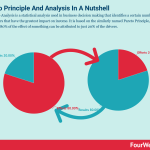

The Pareto Analysis is a statistical analysis used in business decision making that identifies a certain number of input factors that have the greatest impact on income. It is based on the similarly named Pareto Principle, which states that 80% of the effect of something can be attributed to just 20% of the drivers.
Understanding the Pareto AnalysisThe Pareto Analysis was named after Italian economist Vilfredo Pareto, who noted that 80% of the total income earned in Italy went to 20% of the population. In a modern business context, the principle is evident in a variety of settings.
For example:
20% of a product range accounts for 80% of profits.80% of customer complaints relate to 20% of products or services.20% of the workforce accounts for 80% of company revenue.80% of meeting decisions come in 20% of the total meeting time.Conducting a Pareto AnalysisAlthough the applications of a Pareto Analysis are vast, certain principles will apply to most situations.
Following is a six-step process that businesses can use.
1. Identify the problemsStart by writing a list of the problems that need resolving.
2. Identify root causesThen, identify the fundamental cause of each problem. Note that there could be multiple causes of a single problem.
3. Score the problemsIn step 3, it is time to score each problem. The scoring method being utilized will depend on the industry and the nature of the problem itself. For example, a business trying to increase profits might score each problem based on how much it is costing them.
Indeed, cost is a common problem in business. But problems can also be scored based on duration or the number of times they occur in a specified period.
4. Group problemsGroup the problems according to the root cause. Perhaps a group is focused on customer satisfaction, while another on quality control.
5. Tally the scoresNow, add the scores for each group. The group with the highest score is the top priority, as it is part of the 20% of factors causing 80% of the problems. Sometimes, two or even three groups may be causing the majority of problems.
6. ActionLastly, allocate resources to the problems with the highest scores and thus the most potential to impact on profits, customers, or sales.
Advantages of the Pareto AnalysisEfficiency. The analysis allows businesses to quickly and accurately identify factors that are contributing to a significant proportion of their problems.Problem-solving ability. Many workplace problems are intangible in the sense that personnel does not agree on their scope or even on their definition. The Pareto Analysis allows people to come to a consensus on the main problems facing an organization. This also increases morale and cohesiveness in the process.Improved decision making. A company that can quantify its main problems is better able to make decisions to counteract them. Quantifiable problems are also better prepared for so that they have less chance of recurring in the future.Key takeawaysFundamentally, the Pareto Analysis is a statistical technique that identifies a limited number of factors that produce a significant overall effect.The Pareto Analysis has a vast range of applications in business settings, allowing organizations to target problems that erode profits or budget expenditure.The Pareto Analysis is an efficient technique that brings personnel together to quantify and then work to address tangible problems.Connected Business Concepts As highlighted by German psychologist Gerd Gigerenzer in the paper “Heuristic Decision Making,” the term heuristic is of Greek origin, meaning “serving to find out or discover.” More precisely, a heuristic is a fast and accurate way to make decisions in the real world, which is driven by uncertainty.
As highlighted by German psychologist Gerd Gigerenzer in the paper “Heuristic Decision Making,” the term heuristic is of Greek origin, meaning “serving to find out or discover.” More precisely, a heuristic is a fast and accurate way to make decisions in the real world, which is driven by uncertainty. Bounded rationality is a concept attributed to Herbert Simon, an economist and political scientist interested in decision-making and how we make decisions in the real world. In fact, he believed that rather than optimizing (which was the mainstream view in the past decades) humans follow what he called satisficing.
Bounded rationality is a concept attributed to Herbert Simon, an economist and political scientist interested in decision-making and how we make decisions in the real world. In fact, he believed that rather than optimizing (which was the mainstream view in the past decades) humans follow what he called satisficing. Second-order thinking is a means of assessing the implications of our decisions by considering future consequences. Second-order thinking is a mental model that considers all future possibilities. It encourages individuals to think outside of the box so that they can prepare for every and eventuality. It also discourages the tendency for individuals to default to the most obvious choice.
Second-order thinking is a means of assessing the implications of our decisions by considering future consequences. Second-order thinking is a mental model that considers all future possibilities. It encourages individuals to think outside of the box so that they can prepare for every and eventuality. It also discourages the tendency for individuals to default to the most obvious choice. Lateral thinking is a business strategy that involves approaching a problem from a different direction. The strategy attempts to remove traditionally formulaic and routine approaches to problem-solving by advocating creative thinking, therefore finding unconventional ways to solve a known problem. This sort of non-linear approach to problem-solving, can at times, create a big impact.
Lateral thinking is a business strategy that involves approaching a problem from a different direction. The strategy attempts to remove traditionally formulaic and routine approaches to problem-solving by advocating creative thinking, therefore finding unconventional ways to solve a known problem. This sort of non-linear approach to problem-solving, can at times, create a big impact. Moonshot thinking is an approach to innovation, and it can be applied to business or any other discipline where you target at least 10X goals. That shifts the mindset, and it empowers a team of people to look for unconventional solutions, thus starting from first principles, by leveraging on fast-paced experimentation.
Moonshot thinking is an approach to innovation, and it can be applied to business or any other discipline where you target at least 10X goals. That shifts the mindset, and it empowers a team of people to look for unconventional solutions, thus starting from first principles, by leveraging on fast-paced experimentation. The concept of cognitive biases was introduced and popularized by the work of Amos Tversky and Daniel Kahneman in 1972. Biases are seen as systematic errors and flaws that make humans deviate from the standards of rationality, thus making us inept at making good decisions under uncertainty.
The concept of cognitive biases was introduced and popularized by the work of Amos Tversky and Daniel Kahneman in 1972. Biases are seen as systematic errors and flaws that make humans deviate from the standards of rationality, thus making us inept at making good decisions under uncertainty. The Dunning-Kruger effect describes a cognitive bias where people with low ability in a task overestimate their ability to perform that task well. Consumers or businesses that do not possess the requisite knowledge make bad decisions. What’s more, knowledge gaps prevent the person or business from seeing their mistakes.
The Dunning-Kruger effect describes a cognitive bias where people with low ability in a task overestimate their ability to perform that task well. Consumers or businesses that do not possess the requisite knowledge make bad decisions. What’s more, knowledge gaps prevent the person or business from seeing their mistakes. Occam’s Razor states that one should not increase (beyond reason) the number of entities required to explain anything. All things being equal, the simplest solution is often the best one. The principle is attributed to 14th-century English theologian William of Ockham.
Occam’s Razor states that one should not increase (beyond reason) the number of entities required to explain anything. All things being equal, the simplest solution is often the best one. The principle is attributed to 14th-century English theologian William of Ockham. The Mandela effect is a phenomenon where a large group of people remembers an event differently from how it occurred. The Mandela effect was first described in relation to Fiona Broome, who believed that former South African President Nelson Mandela died in prison during the 1980s. While Mandela was released from prison in 1990 and died 23 years later, Broome remembered news coverage of his death in prison and even a speech from his widow. Of course, neither event occurred in reality. But Broome was later to discover that she was not the only one with the same recollection of events.
The Mandela effect is a phenomenon where a large group of people remembers an event differently from how it occurred. The Mandela effect was first described in relation to Fiona Broome, who believed that former South African President Nelson Mandela died in prison during the 1980s. While Mandela was released from prison in 1990 and died 23 years later, Broome remembered news coverage of his death in prison and even a speech from his widow. Of course, neither event occurred in reality. But Broome was later to discover that she was not the only one with the same recollection of events. The crowding-out effect occurs when public sector spending reduces spending in the private sector.
The crowding-out effect occurs when public sector spending reduces spending in the private sector. The bandwagon effect tells us that the more a belief or idea has been adopted by more people within a group, the more the individual adoption of that idea might increase within the same group. This is the psychological effect that leads to herd mentality. What is marketing can be associated with social proof.
The bandwagon effect tells us that the more a belief or idea has been adopted by more people within a group, the more the individual adoption of that idea might increase within the same group. This is the psychological effect that leads to herd mentality. What is marketing can be associated with social proof.Read Next: Biases, Bounded Rationality, Mandela Effect, Dunning-Kruger
Read Next: Heuristics, Biases.
Connected resources:
Financial RatiosBalance SheetBusiness AnalysisGross MarginsDecision-MakingAdditional resources:
Business ModelsBusiness StrategyDigital Business ModelsDistribution ChannelsGo-To-Market StrategyMarketing StrategyNetwork EffectsPlatform Business ModelsRevenue ModelsThe post The Pareto Principle And Pareto Analysis In A Nutshell appeared first on FourWeekMBA.
Quality Circle In A Nutshell
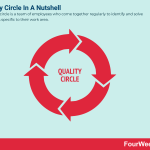

A quality circle is a team of employees who come together regularly to identify and solve problems specific to their work area.
Understanding quality circlesThe quality circle is a participatory management technique where employees meet in teams to identify, discuss, and solve work-related problems.
These teams, which consist of no more than twelve individuals, are normally led by a supervisor or manager and seek to facilitate better standards in the workplace.
Employees who participate in quality circles are sometimes trained in formal problem-solving methods such as the Pareto analysis, cause-and-effect diagrams, and various brainstorming techniques.
After completing any one of these analyses, individuals are encouraged to discuss their conclusions with superiors who have the power to implement solutions.
Quality circles are not a new concept in business, with a study commissioned by the New York Stock Exchange finding that 44% of companies with more than 500 employees were using them as early as 1982.
While hard data are harder to come by today, Harvard Business Review believes that at least 90 of the top Fortune 500 companies have a quality circle program in place.
Some companies, such as IBM, Xerox, and Honeywell, use them extensively.
Objectives of quality circlesIt may appear on the surface that the only objective of a quality circle is to solve workplace problems. In truth, however, there are numerous benefits for employees and the organization as a whole:
Teamwork – quality circles enable employees to hone important collaboration skills and solve critical problems by working together. Personal development – in a similar vein, individuals within the team develop better communication, critical thinking, and leadership skills. The perspectives, knowledge, and experience of one person are also enhanced by those shared by another.Attitude – quality circles allow employees to feel like their opinions or contributions are valued by the organization. An attitude of continuous improvement increases employee motivation and the efficiency of processes and procedures.Structure of a quality circleThe structure of a quality circle is somewhat flexible, but in many cases is comprised of the following stakeholders:
Members – the employees who participate in the process, undertake formal training, and present solutions to management.Non-members – those employees who choose not to participate in the quality circle but have important ideas to put forward.Leaders – a member-elected individual who ensures meetings run smoothly and serve the desired purpose. Some quality circles may also appoint a deputy leader.Coordinator – these individuals establish quality circles, train leaders and members, and report information back to the steering committee.Steering committee – individuals within upper management who ensure meetings remain on track and act on employee recommendations.Coordinating agency – an agency that manages the budget, organizes employee training, and ensures quality circles are incorporated into business operations.Key takeaways:A quality circle is a team of employees who come together regularly to identify and solve problems specific to their work area.It may appear that the only objective of a quality circle is to solve workplace problems, but they also serve to increase employee skills, motivation, and productivity.Various stakeholders participate in the quality circle process. These include members, non-members, leaders, coordinators, steering committees, and a coordinating agency.The post Quality Circle In A Nutshell appeared first on FourWeekMBA.
History of Coca-Cola
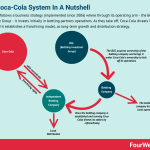

The cola beverage which gave rise to The Coca-Cola Company was invented in 1886, so it is perhaps no surprise that the drink and the company itself has a long and storied history.
In this article, we’ll explore some of the twists and turns of this iconic brand and how it grew into the global force it is today.
Birth in AtlantaAddicted to morphine after being wounded in the American Civil war, Atlanta pharmacist John Pemberton developed a substitute for the drug in the form of flavored syrup.
The syrup, which contained coca leaf extract and caffeine, was marketed as a patent medicine that could cure anything from nerve disorders to addiction, headaches, upset stomach, and impotence.
When some states passed prohibition legislation in the late 1800s, Pemberton also capitalized on support for the temperance movement by claiming that the drink was a healthy alternative to alcohol.
He took his concoction down the street to Jacobs’ Pharmacy where it was first sold from a soda fountain for the princely sum of 5 cents a glass.
Origins of the Coca-Cola nameThe person credited for naming the soda is Frank M. Robinson, Pemberton’s partner and bookkeeper who believed that “the two Cs would look well in advertising.”
The first ever advertisement for Coca-Cola then appeared in The Atlanta Journal with oilcloth banners also draped over shop awnings. Coupons advertising free drinks were also advertised, which was considered an innovative marketing tactic at the time.
During the first year, sales of the drink averaged 9 servings per day.
Pemberton’s death and sale of the companyBy 1888, three different versions of Coca-Cola sold by three different companies were on the market.
Soon thereafter, Pemberton became ill and was nearly bankrupt since the drink cost more to make than he was earning in revenue.
He then entered into a partnership with four Atlanta businessmen to sell parts of the business.
Codified by a verbal agreement, Pemberton stated that the Coca-Cola trademark would belong to his son Charley, but the other manufacturers could use his formula.
The Coca-Cola Company was incorporated in March 1888 with Charley Pemberton a major shareholder due to his ownership of the “Coca-Cola” name.
Pemberton then succumbed to stomach cancer five months later, but before his death, he acted as a consignor for Charley who sold a 33% interest in the recipe for Coca-Cola to pharmacist Asa Griggs Candler.
Securing controlAfter Pemberton died, Candler started selling a similar drink to Coca-Cola. But since Charley Pemberton owned the rights to the name, Candler was forced to use brand names such as “Koke” and “Yum Yum” which were not popular with consumers.
While stories differ on what happened next, most believe that Candler moved swiftly to obtain greater control over the company.
One story states that Candler arrived at Pemberton’s funeral to buy the trademark from Charley’s mother for $300 cash, while another is that he tried to force two of the businessmen in Pemberton’s original partnership out of the business.
However, when Charley Pemberton died of a suspected drug overdose in 1894, Candler attained sole control over the company more or less by default.
ExpansionBy 1895, Coca-Cola was enjoyed across the United States with expansion into Cuba in 1899 and Europe in 1901.
Around this time, Candler sold the bottling rights to three businessmen from Tennessee who had some of the earliest technology that could bottle drinks at scale.
Candler sold the rights for just $1 and would later regret not asking for more. But with the first botting facility established in Chattanooga in 1899, he nevertheless set the company on a path to world domination in the beverage industry.
Key takeaways:The cola beverage which gave rise to The Coca-Cola Company was invented in 1886, so it is perhaps no surprise that the drink and company itself has a long and storied history.Addicted to morphine after being wounded in the American Civil war, Atlanta pharmacist John Pemberton developed a substitute for the drug in the form of a flavored syrup that contained caffeine and coca leaf extract.After a series of protracted and complex deals over the rights to the Coca-Cola trademark and recipe, Asa Griggs Candler gained control over the company after Charley Pemberton’s death in 1894. His decision to sell the bottling rights to a concern in Tennessee enabled the company to distribute bottled drinks at scale.Read Next: Coca-Cola Business And Distribution, Coca-Cola Mission Statement and Vision Statement, Coca-Cola SWOT Analysis, Coca-Cola Organizational Structure, Coca-Cola PESTEL Analysis, Coca-Cola Competitors, What Does Coca-Cola Own?
The post History of Coca-Cola appeared first on FourWeekMBA.
September 8, 2022
What Is The Minto Pyramid Principle? The Minto Pyramid Principle In A Nutshell
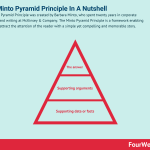

The Minto Pyramid Principle was created by Barbara Minto, who spent twenty years in corporate reporting and writing at McKinsey & Company. The Minto Pyramid Principle is a framework enabling writers to attract the attention of the reader with a simple yet compelling and memorable story.
Understanding the Minto Pyramid PrincipleAfter she left the organization in 1973, Minto began her own consulting business to help business leaders write with conviction. Those lessons combined with her extensive corporate experience were then distilled into the Minto Pyramid Principle.
The principle is based on the premise that an argument is easier to understand – and far more convincing – when it is arranged in a pyramidal hierarchy. At the top of the pyramid sits the most important takeaway message of the piece, which is then followed by layers of evidence that flow in a logical order. Structuring the article in this way allows the reader to absorb a central idea and then be presented with information that supports it.
While the Minto Pyramid Principle is used to attract the attention of time-poor executives, it is arguably more effective as a persuasive communication tool. An entrepreneur may use the pyramid to win over prospective investors, while a leader may use it to communicate with project stakeholders during a proposal.
The three levels of the Minto Pyramid Principle hierarchyThree levels comprise the Minto Pyramid Principle.
The bottom of the pyramid comprises the data and factual information that support arguments. From there, the writer should move through increasingly abstract levels until they arrive at their core message.
Let’s take a look at each level below, starting at the top.
1 – The answerThe answer is simply a clear, concise, and effective core message that has four components:
Situation – good writers set the scene by describing a situation to create a mental picture in the mind of the reader.Complication – what is the factor causing the conflict, problem, or opportunity? These factors should compel the reader to act, or at the very least, continue reading.Question – then, a question is posed to highlight the decision an individual or business must face. The question should extend logically from the complication.Answer – or a recommendation that solves the problem and ensures the story has a happy ending. For businesses, solutions need to be mutually exclusive and collectively exhaustive (MECE).2 – Supporting argumentsSupporting arguments should then be sorted, grouped, and summarised in a logical way. To facilitate this process, the Minto Pyramid Principle suggests “ideas in writing should always form a pyramid under a single thought.”
In other words, each supporting argument should resemble a mini-pyramid, complete with its own single thought (answer) and supporting arguments, data, and facts.
As a general rule, each single thought should be backed by three supporting arguments. Ideas at any level in the pyramid must also be summaries of the ideas grouped below them.
3- Supporting data or factsAs the name suggests, the bottom of the pyramid houses the evidence, data, and other findings that validate the supporting arguments.
Where applicable, it may also be wise to include customer testimonials on this level.
Key takeaways:The Minto Pyramid Principle is a framework enabling writers to attract the attention of the reader with a simple yet compelling and memorable story. It was developed by corporate writing consultant Barbara Minto.The Minto Pyramid Principle is traditionally used to attract the attention of time-poor executives, but it is also useful as a persuasive communication tool.The Minto Pyramid Principle has three levels. At the top of the pyramid is the answer, or a clear and concise core message that answers a question or solves a problem. Two more levels represent supporting arguments and supporting data and facts respectively.Connected Business Frameworks You can use the Ansoff Matrix as a strategic framework to understand what growth strategy is more suited based on the market context. Developed by mathematician and business manager Igor Ansoff, it assumes a growth strategy can be derived by whether the market is new or existing, and the product is new or existing.
You can use the Ansoff Matrix as a strategic framework to understand what growth strategy is more suited based on the market context. Developed by mathematician and business manager Igor Ansoff, it assumes a growth strategy can be derived by whether the market is new or existing, and the product is new or existing. The GE McKinsey Matrix was developed in the 1970s after General Electric asked its consultant McKinsey to develop a portfolio management model. This matrix is a strategy tool that provides guidance on how a corporation should prioritize its investments among its business units, leading to three possible scenarios: invest, protect, harvest, and divest.
The GE McKinsey Matrix was developed in the 1970s after General Electric asked its consultant McKinsey to develop a portfolio management model. This matrix is a strategy tool that provides guidance on how a corporation should prioritize its investments among its business units, leading to three possible scenarios: invest, protect, harvest, and divest.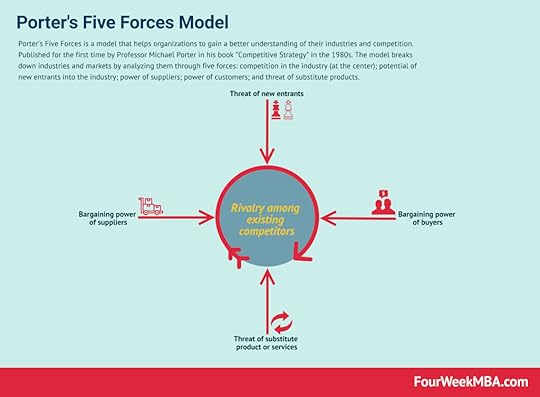 Porter’s Five Forces is a model that helps organizations to gain a better understanding of their industries and competition. Published for the first time by Professor Michael Porter in his book “Competitive Strategy” in the 1980s. The model breaks down industries and markets by analyzing them through five forces
Porter’s Five Forces is a model that helps organizations to gain a better understanding of their industries and competition. Published for the first time by Professor Michael Porter in his book “Competitive Strategy” in the 1980s. The model breaks down industries and markets by analyzing them through five forces The McKinsey 7-S Model was developed in the late 1970s by Robert Waterman and Thomas Peters, who were consultants at McKinsey & Company. Waterman and Peters created seven key internal elements that inform a business of how well positioned it is to achieve its goals, based on three hard elements and four soft elements.
The McKinsey 7-S Model was developed in the late 1970s by Robert Waterman and Thomas Peters, who were consultants at McKinsey & Company. Waterman and Peters created seven key internal elements that inform a business of how well positioned it is to achieve its goals, based on three hard elements and four soft elements.  According to Michael Porter, a competitive advantage, in a given industry could be pursued in two key ways: low cost (cost leadership), or differentiation. A third generic strategy is focus. According to Porter a failure to do so would end up stuck in the middle scenario, where the company will not retain a long-term competitive advantage.
According to Michael Porter, a competitive advantage, in a given industry could be pursued in two key ways: low cost (cost leadership), or differentiation. A third generic strategy is focus. According to Porter a failure to do so would end up stuck in the middle scenario, where the company will not retain a long-term competitive advantage. According to Porter there are three core strategies for competitive positioning: cost leadership, differentiation and focus. Cost leadership is straightforward, as the player rolling this out will become the lost-cost producer in the industry.
According to Porter there are three core strategies for competitive positioning: cost leadership, differentiation and focus. Cost leadership is straightforward, as the player rolling this out will become the lost-cost producer in the industry.  In his 1985 book Competitive Advantage, Porter explains that a value chain is a collection of processes that a company performs to create value for its consumers. As a result, he asserts that value chain analysis is directly linked to competitive advantage. Porter’s Value Chain Model is a strategic management tool developed by Harvard Business School professor Michael Porter. The tool analyses a company’s value chain – defined as the combination of processes that the company uses to make money.
In his 1985 book Competitive Advantage, Porter explains that a value chain is a collection of processes that a company performs to create value for its consumers. As a result, he asserts that value chain analysis is directly linked to competitive advantage. Porter’s Value Chain Model is a strategic management tool developed by Harvard Business School professor Michael Porter. The tool analyses a company’s value chain – defined as the combination of processes that the company uses to make money. Porter’s Diamond Model is a diamond-shaped framework that explains why specific industries in a nation become internationally competitive while those in other nations do not. The model was first published in Michael Porter’s 1990 book The Competitive Advantage of Nations. This framework looks at the firm strategy, structure/rivalry, factor conditions, demand conditions, related and supporting industries.
Porter’s Diamond Model is a diamond-shaped framework that explains why specific industries in a nation become internationally competitive while those in other nations do not. The model was first published in Michael Porter’s 1990 book The Competitive Advantage of Nations. This framework looks at the firm strategy, structure/rivalry, factor conditions, demand conditions, related and supporting industries. A SWOT Analysis is a framework used for evaluating the business’s Strengths, Weaknesses, Opportunities, and Threats. It can aid in identifying the problematic areas of your business so that you can maximize your opportunities. It will also alert you to the challenges your organization might face in the future.
A SWOT Analysis is a framework used for evaluating the business’s Strengths, Weaknesses, Opportunities, and Threats. It can aid in identifying the problematic areas of your business so that you can maximize your opportunities. It will also alert you to the challenges your organization might face in the future. The PESTEL analysis is a framework that can help marketers assess whether macro-economic factors are affecting an organization. This is a critical step that helps organizations identify potential threats and weaknesses that can be used in other frameworks such as SWOT or to gain a broader and better understanding of the overall marketing environment.
The PESTEL analysis is a framework that can help marketers assess whether macro-economic factors are affecting an organization. This is a critical step that helps organizations identify potential threats and weaknesses that can be used in other frameworks such as SWOT or to gain a broader and better understanding of the overall marketing environment. A blue ocean is a strategy where the boundaries of existing markets are redefined, and new uncontested markets are created. At its core, there is value innovation, for which uncontested markets are created, where competition is made irrelevant. And the cost-value trade-off is broken. Thus, companies following a blue ocean strategy offer much more value at a lower cost for the end customers.
A blue ocean is a strategy where the boundaries of existing markets are redefined, and new uncontested markets are created. At its core, there is value innovation, for which uncontested markets are created, where competition is made irrelevant. And the cost-value trade-off is broken. Thus, companies following a blue ocean strategy offer much more value at a lower cost for the end customers.Main Free Guides:
Business ModelsBusiness StrategyBusiness DevelopmentDigital Business ModelsDistribution ChannelsMarketing StrategyPlatform Business ModelsTech Business ModelThe post What Is The Minto Pyramid Principle? The Minto Pyramid Principle In A Nutshell appeared first on FourWeekMBA.
What Is Management By Objectives? The Management By Objectives In A Nutshell
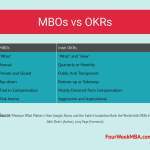

Management by objectives was popularised by notable management consultant Peter Drucker in his 1954 book The Practice of Management. Management by objectives (MBO) is a model used to improve organizational performance by defining objectives agreed upon by both management and employees.
Understanding management by objectivesThe methodology suggests first defining organizational objectives management can convey to subordinates. Both parties subsequently work together to determine how each objective will be achieved in a sequence. Using this management system, individual goals are synchronized with organizational goals and a calm and productive work environment is created by leaders.
Ultimately, the model suggests employees involved in goal setting and action plan formation are more likely to behave in ways that align with organizational objectives. Better communication between the manager and the employee also increases motivation and buy-in.
Management by objectives in practiceThere are five generally accepted steps to management by objectives:
Define organizational goals – these must be realistic, achievable, and well defined. Setting one to three organizational goals that can be achieved in the long-term is most effective.Define employee objectives – in other words, the measurable steps the employee must take to achieve organizational goals. Managers must work with subordinates on an individual basis to establish goals they can realistically achieve using the available resources. Each employee must also be willing to participate in the process.Monitor progress and performance – consider tracking sheets to monitor progress and periodic team meetings to recognize incremental achievements or tackle challenges.Evaluate performance and provide feedback – managers must then return to the measurable steps defined in the second phase to evaluate employee performance. Extra guidance should be provided if performance is below par. Positive feedback should also be given at every opportunity to maintain motivation and productivity.Performance appraisal – this involves the work of each employee being assessed over the life of the project. Appraisals highlight where an individual excelled and where there is still room for growth. Used correctly, these reviews can be an important driver of personal and professional growth.Management by objectives examplesTo get a better sense of management by objectives, we have listed some key organizational objectives below by department.
Company performanceBecome a member of the Fortune 500 group of companies.Increase asset to debt ratio by 10%.Achieve a payback period of 18 months for new products.MarketingIncrease marketing ROI by 9.5%.Increase landing page conversion rates by 26%.Implement continuous A/B testing of landing pages.Human resourcesMaintain a quarterly retention rate of 95%.Hold a minimum of two interviews for new hires.Assign at least a third of all managerial positions to internal applicants.Product managementMaintain an 85% customer satisfaction (CSAT) score.Meet with at least five high-value clients to gauge product feedback.Analyze the product strategies of three direct competitors.Customer successDecrease the number of customer support tickets during onboarding by 40%.Decrease customer churn rate by 20%.Maintain a detailed profile for each premium client.Key takeaways:Management by objectives is a model used to improve organizational performance by defining objectives agreed upon by both management and employees. It was developed by notable management consultant Peter Drucker in 1954.Management by objectives suggests employees involved in goal setting and action plan formation are more likely to behave in ways that align with organizational objectives. This also fosters better communication and relationships between managers and subordinates.Management by objectives can be described by five general steps: define organizational goals, define employee objectives, monitor progress and performance, evaluate performance and provide feedback, and performance appraisal.Other Goal-Setting Frameworks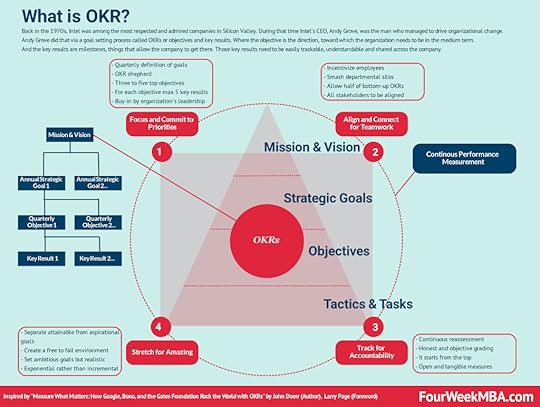 Andy Grove, helped Intel become among the most valuable companies by 1997. In his years at Intel, he conceived a management and goal-setting system, called OKR, standing for “objectives and key results.” Venture capitalist and early investor in Google, John Doerr, systematized in the book “Measure What Matters.”
Andy Grove, helped Intel become among the most valuable companies by 1997. In his years at Intel, he conceived a management and goal-setting system, called OKR, standing for “objectives and key results.” Venture capitalist and early investor in Google, John Doerr, systematized in the book “Measure What Matters.”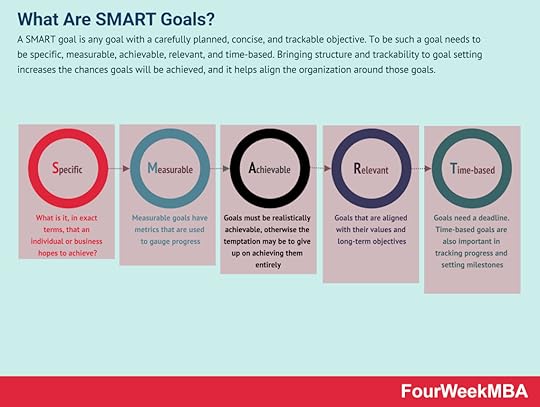 A SMART goal is any goal with a carefully planned, concise, and trackable objective. To be such a goal needs to be specific, measurable, achievable, relevant, and time-based. Bringing structure and trackability to goal setting increases the chances goals will be achieved, and it helps align the organization around those goals.
A SMART goal is any goal with a carefully planned, concise, and trackable objective. To be such a goal needs to be specific, measurable, achievable, relevant, and time-based. Bringing structure and trackability to goal setting increases the chances goals will be achieved, and it helps align the organization around those goals.
 First proposed by accounting academic Robert Kaplan, the balanced scorecard is a management system that allows an organization to focus on big-picture strategic goals. The four perspectives of the balanced scorecard include financial, customer, business process, and organizational capacity. From there, according to the balanced scorecard, it’s possible to have a holistic view of the business.
First proposed by accounting academic Robert Kaplan, the balanced scorecard is a management system that allows an organization to focus on big-picture strategic goals. The four perspectives of the balanced scorecard include financial, customer, business process, and organizational capacity. From there, according to the balanced scorecard, it’s possible to have a holistic view of the business.
 Businesses use backcasting to plan for a desired future by determining the steps required to achieve that future. Backcasting is the opposite of forecasting, where a business sets future goals and works toward them by maintaining the status quo.
Businesses use backcasting to plan for a desired future by determining the steps required to achieve that future. Backcasting is the opposite of forecasting, where a business sets future goals and works toward them by maintaining the status quo.
 Maslow’s Hierarchy of Needs was developed by American psychologist Abraham Maslow. His hierarchy, often depicted in the shape of a pyramid, helped explain his research on basic human needs and desires. In marketing, the hierarchy (and its basis in psychology) can be used to market to specific groups of people based on their similarly specific needs, desires, and resultant actions.
Maslow’s Hierarchy of Needs was developed by American psychologist Abraham Maslow. His hierarchy, often depicted in the shape of a pyramid, helped explain his research on basic human needs and desires. In marketing, the hierarchy (and its basis in psychology) can be used to market to specific groups of people based on their similarly specific needs, desires, and resultant actions.
 Herzberg’s two-factor theory argues that certain workplace factors cause job satisfaction while others cause job dissatisfaction. The theory was developed by American psychologist and business management analyst Frederick Herzberg. Until his death in 2000, Herzberg was widely regarded as a pioneering thinker in motivational theory.
Herzberg’s two-factor theory argues that certain workplace factors cause job satisfaction while others cause job dissatisfaction. The theory was developed by American psychologist and business management analyst Frederick Herzberg. Until his death in 2000, Herzberg was widely regarded as a pioneering thinker in motivational theory.
 The theory was developed by psychologist Edwin Locke who also has a background in motivation and leadership research. Locke’s goal-setting theory of motivation provides a framework for setting effective and motivating goals. Locke was able to demonstrate that goal setting was linked to performance.
The theory was developed by psychologist Edwin Locke who also has a background in motivation and leadership research. Locke’s goal-setting theory of motivation provides a framework for setting effective and motivating goals. Locke was able to demonstrate that goal setting was linked to performance.Nadler-Tushman Congruence Model
 The Nadler-Tushman Congruence Model was created by David Nadler and Michael Tushman at Columbia University. The Nadler-Tushman Congruence Model is a diagnostic tool that identifies problem areas within a company. In the context of business, congruence occurs when the goals of different people or interest groups coincide.
The Nadler-Tushman Congruence Model was created by David Nadler and Michael Tushman at Columbia University. The Nadler-Tushman Congruence Model is a diagnostic tool that identifies problem areas within a company. In the context of business, congruence occurs when the goals of different people or interest groups coincide.
 The SWOT analysis is commonly used as a strategic planning tool in business. However, it is also well suited for personal use in addressing a specific goal or problem. A personal SWOT analysis helps individuals identify their strengths, weaknesses, opportunities, and threats.
The SWOT analysis is commonly used as a strategic planning tool in business. However, it is also well suited for personal use in addressing a specific goal or problem. A personal SWOT analysis helps individuals identify their strengths, weaknesses, opportunities, and threats.
 The OGSM framework is a means of creating a well-structured and actionable marketing strategy. Fundamentally, the OGSM framework allows businesses to first define what they want to achieve and then determine how they will get there. To provide direction for marketing teams, the acronym of OGSM (objectives, goals, strategies, measures) should be followed in sequential order. Here is a look at each in more detail.
The OGSM framework is a means of creating a well-structured and actionable marketing strategy. Fundamentally, the OGSM framework allows businesses to first define what they want to achieve and then determine how they will get there. To provide direction for marketing teams, the acronym of OGSM (objectives, goals, strategies, measures) should be followed in sequential order. Here is a look at each in more detail.
 The McKinsey 7-S Model was developed in the late 1970s by Robert Waterman and Thomas Peters, who were consultants at McKinsey & Company. Waterman and Peters created seven key internal elements that inform a business of how well positioned it is to achieve its goals, based on three hard elements and four soft elements.
The McKinsey 7-S Model was developed in the late 1970s by Robert Waterman and Thomas Peters, who were consultants at McKinsey & Company. Waterman and Peters created seven key internal elements that inform a business of how well positioned it is to achieve its goals, based on three hard elements and four soft elements.
 A personal mission statement clarifies what is important in life to an individual. A personal mission statement is a written statement of purpose that allows individuals to define their calling in life. It helps clarify goals, values, beliefs, or passions, communicate them, and better execute a personal growth strategy.
A personal mission statement clarifies what is important in life to an individual. A personal mission statement is a written statement of purpose that allows individuals to define their calling in life. It helps clarify goals, values, beliefs, or passions, communicate them, and better execute a personal growth strategy.Main Free Guides:
Business ModelsBusiness StrategyBusiness DevelopmentDigital Business ModelsDistribution ChannelsMarketing StrategyPlatform Business ModelsTech Business ModelThe post What Is Management By Objectives? The Management By Objectives In A Nutshell appeared first on FourWeekMBA.
Needs Vs. Wants In Marketing
In marketing, it is critical to understand the difference between the needs and wants of the target audience. Consumer needs are essential for business sustainability, while consumer wants provide important marketplace differentiation for the business itself.
Understanding needs vs. wants in marketing A marketing strategy is the “what” and “how” to build a sustainable value chain framed for a target customer. A powerful marketing strategy needs to be able to manufacture desire, amplify the underlying value proposition, and build a brand that feels unique in the mind of its customers.
A marketing strategy is the “what” and “how” to build a sustainable value chain framed for a target customer. A powerful marketing strategy needs to be able to manufacture desire, amplify the underlying value proposition, and build a brand that feels unique in the mind of its customers.Many businesses sell products or services that satisfy basic human requirements. Cars are one such example since most consumers have a fundamental need for transportation. Companies that sell food, drink, safety, or shelter-based needs also fall under this umbrella. What’s more, they have become highly skilled at extolling the rational and logical benefits of their products to drive sales.
For the most part however, consumers tend to purchase on emotion. In other words, they purchase according to wants. The consumer looking for a new car might want a five-star safety rating, metallic paint, and an automatic transmission. What they need are four wheels and an engine. In a market where every new car satisfies these needs, consumer wants provide an important point of difference in marketing strategies.
For businesses and their marketing teams, understanding the difference between needs and wants is important. Needs represent basic requirements, functions, or features consumers expect to be satisfied. Wants, as we have already discussed, are points of differentiation and are generally not essential to human survival. If used correctly, however, they can turn a satisfied customer into a loyal and devoted follower.
 Digital marketing is a sub-set of marketing which uses the Internet, and online platforms to drive a marketing strategy. Digital marketing channels offer opportunities to reach small audiences with a high degree of personalization, thus growing businesses even with lower budgets and a better understanding of those audiences.Determining consumer wants
Digital marketing is a sub-set of marketing which uses the Internet, and online platforms to drive a marketing strategy. Digital marketing channels offer opportunities to reach small audiences with a high degree of personalization, thus growing businesses even with lower budgets and a better understanding of those audiences.Determining consumer wantsMarketing to consumer wants means first determining what they are.
Businesses with existing products can simply ask their customers why they purchase from them. Why do they want the product? What does it do for them beyond functionality?
When determining wants, emotional triggers are a good place to start.
The car buyer looking for an automatic transmission may want a simpler way to drive in peak hour traffic. Their emotional trigger might stem from feelings of relief and comfort.
The car buyer looking for a five-star safety rating may want peace of mind for their young family. Here, the emotional triggers may be security, contentment, or even fear.
The car buyer looking for metallic paint may want a modern look that does not fade as quickly as other types of paint. They want to feel satisfied, proud, and happy.
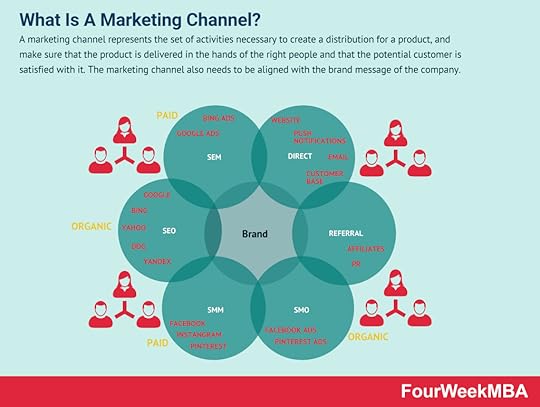 A marketing channel represents the set of activities necessary to create a distribution for a product and make sure that the product is delivered in the hands of the right people and that the potential customer is satisfied with it. The marketing channel also needs to be aligned with the brand message of the company.Demands
A marketing channel represents the set of activities necessary to create a distribution for a product and make sure that the product is delivered in the hands of the right people and that the potential customer is satisfied with it. The marketing channel also needs to be aligned with the brand message of the company.Demands Customer obsession goes beyond quantitative and qualitative data about customers, and it moves around customers’ feedback to gather valuable insights. Those insights start by the entrepreneur’s wandering process, driven by hunch, gut, intuition, curiosity, and a builder mindset. The product discovery moves around a building, reworking, experimenting, and iterating loop.
Customer obsession goes beyond quantitative and qualitative data about customers, and it moves around customers’ feedback to gather valuable insights. Those insights start by the entrepreneur’s wandering process, driven by hunch, gut, intuition, curiosity, and a builder mindset. The product discovery moves around a building, reworking, experimenting, and iterating loop.A sometimes overlooked aspect of needs and wants in marketing are demands.
Essentially, wants turn into demands when a consumer has the financial means to purchase a want. Many consumers want a luxury 100-foot yacht, but few could afford the asking price. Nevertheless, yacht companies have responded to the demands of the ultra-rich and made them available for sale.
Demands, like needs and wants, will vary according to the target audience. Demands will also be influenced by societal and cultural norms and market conditions. As a result, marketing teams must craft campaigns that reflect an understanding of who the customer is and what they are willing (or able) to pay for.
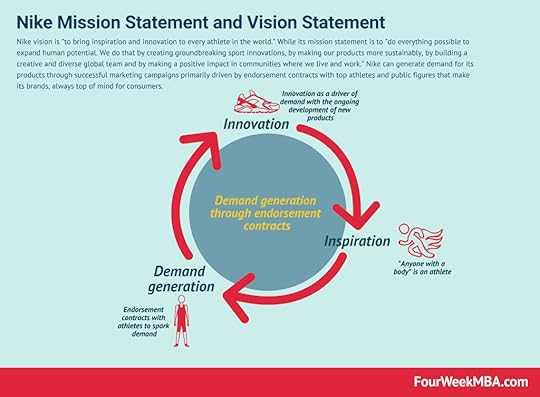 Nike vision is “to bring inspiration and innovation to every athlete in the world.” While its mission statement is to “do everything possible to expand human potential. We do that by creating groundbreaking sport innovations, by making our products more sustainably, by building a creative and diverse global team and by making a positive impact in communities where we live and work.”Key takeaways:In marketing, consumer needs are basic functions or features they expect to be satisfied. Purchases based on consumer needs tend to be logical and rational and represent elements critical to human survival or functioning.Consumer wants are features non-essential to product function that provide businesses with market differentiation. These purchases tend to be based on positive or negative emotions.Consumer demands are wants a consumer has the financial means to purchase. Effective marketing campaigns must consider the wants of an individual buyer and whether they can afford to pay for them. Ultimately, this has important implications for product viability.Connected Decision-Making Frameworks
Nike vision is “to bring inspiration and innovation to every athlete in the world.” While its mission statement is to “do everything possible to expand human potential. We do that by creating groundbreaking sport innovations, by making our products more sustainably, by building a creative and diverse global team and by making a positive impact in communities where we live and work.”Key takeaways:In marketing, consumer needs are basic functions or features they expect to be satisfied. Purchases based on consumer needs tend to be logical and rational and represent elements critical to human survival or functioning.Consumer wants are features non-essential to product function that provide businesses with market differentiation. These purchases tend to be based on positive or negative emotions.Consumer demands are wants a consumer has the financial means to purchase. Effective marketing campaigns must consider the wants of an individual buyer and whether they can afford to pay for them. Ultimately, this has important implications for product viability.Connected Decision-Making Frameworks The Cynefin Framework gives context to decision making and problem-solving by providing context and guiding an appropriate response. The five domains of the Cynefin Framework comprise obvious, complicated, complex, chaotic domains and disorder if a domain has not been determined at all.
The Cynefin Framework gives context to decision making and problem-solving by providing context and guiding an appropriate response. The five domains of the Cynefin Framework comprise obvious, complicated, complex, chaotic domains and disorder if a domain has not been determined at all.  A SWOT Analysis is a framework used for evaluating the business’s Strengths, Weaknesses, Opportunities, and Threats. It can aid in identifying the problematic areas of your business so that you can maximize your opportunities. It will also alert you to the challenges your organization might face in the future.
A SWOT Analysis is a framework used for evaluating the business’s Strengths, Weaknesses, Opportunities, and Threats. It can aid in identifying the problematic areas of your business so that you can maximize your opportunities. It will also alert you to the challenges your organization might face in the future. The SWOT analysis is commonly used as a strategic planning tool in business. However, it is also well suited for personal use in addressing a specific goal or problem. A personal SWOT analysis helps individuals identify their strengths, weaknesses, opportunities, and threats.
The SWOT analysis is commonly used as a strategic planning tool in business. However, it is also well suited for personal use in addressing a specific goal or problem. A personal SWOT analysis helps individuals identify their strengths, weaknesses, opportunities, and threats. The Pareto Analysis is a statistical analysis used in business decision making that identifies a certain number of input factors that have the greatest impact on income. It is based on the similarly named Pareto Principle, which states that 80% of the effect of something can be attributed to just 20% of the drivers.
The Pareto Analysis is a statistical analysis used in business decision making that identifies a certain number of input factors that have the greatest impact on income. It is based on the similarly named Pareto Principle, which states that 80% of the effect of something can be attributed to just 20% of the drivers.Failure Mode And Effects Analysis
 A failure mode and effects analysis (FMEA) is a structured approach to identifying design failures in a product or process. Developed in the 1950s, the failure mode and effects analysis is one the earliest methodologies of its kind. It enables organizations to anticipate a range of potential failures during the design stage.
A failure mode and effects analysis (FMEA) is a structured approach to identifying design failures in a product or process. Developed in the 1950s, the failure mode and effects analysis is one the earliest methodologies of its kind. It enables organizations to anticipate a range of potential failures during the design stage.  A Blindspot Analysis is a means of unearthing incorrect or outdated assumptions that can harm decision making in an organization. The term “blindspot analysis” was first coined by American economist Michael Porter. Porter argued that in business, outdated ideas or strategies had the potential to stifle modern ideas and prevent them from succeeding. Furthermore, decisions a business thought were made with care caused projects to fail because major factors had not been duly considered.
A Blindspot Analysis is a means of unearthing incorrect or outdated assumptions that can harm decision making in an organization. The term “blindspot analysis” was first coined by American economist Michael Porter. Porter argued that in business, outdated ideas or strategies had the potential to stifle modern ideas and prevent them from succeeding. Furthermore, decisions a business thought were made with care caused projects to fail because major factors had not been duly considered. A comparable company analysis is a process that enables the identification of similar organizations to be used as a comparison to understand the business and financial performance of the target company. To find comparables you can look at two key profiles: the business and financial profile. From the comparable company analysis it is possible to understand the competitive landscape of the target organization.
A comparable company analysis is a process that enables the identification of similar organizations to be used as a comparison to understand the business and financial performance of the target company. To find comparables you can look at two key profiles: the business and financial profile. From the comparable company analysis it is possible to understand the competitive landscape of the target organization. A cost-benefit analysis is a process a business can use to analyze decisions according to the costs associated with making that decision. For a cost analysis to be effective it’s important to articulate the project in the simplest terms possible, identify the costs, determine the benefits of project implementation, assess the alternatives.
A cost-benefit analysis is a process a business can use to analyze decisions according to the costs associated with making that decision. For a cost analysis to be effective it’s important to articulate the project in the simplest terms possible, identify the costs, determine the benefits of project implementation, assess the alternatives. Agile Business Analysis (AgileBA) is certification in the form of guidance and training for business analysts seeking to work in agile environments. To support this shift, AgileBA also helps the business analyst relate Agile projects to a wider organizational mission or strategy. To ensure that analysts have the necessary skills and expertise, AgileBA certification was developed.
Agile Business Analysis (AgileBA) is certification in the form of guidance and training for business analysts seeking to work in agile environments. To support this shift, AgileBA also helps the business analyst relate Agile projects to a wider organizational mission or strategy. To ensure that analysts have the necessary skills and expertise, AgileBA certification was developed. A SOAR analysis is a technique that helps businesses at a strategic planning level to:Focus on what they are doing right.Determine which skills could be enhanced.Understand the desires and motivations of their stakeholders.
A SOAR analysis is a technique that helps businesses at a strategic planning level to:Focus on what they are doing right.Determine which skills could be enhanced.Understand the desires and motivations of their stakeholders. The STEEPLE analysis is a variation of the STEEP analysis. Where the step analysis comprises socio-cultural, technological, economic, environmental/ecological, and political factors as the base of the analysis. The STEEPLE analysis adds other two factors such as Legal and Ethical.
The STEEPLE analysis is a variation of the STEEP analysis. Where the step analysis comprises socio-cultural, technological, economic, environmental/ecological, and political factors as the base of the analysis. The STEEPLE analysis adds other two factors such as Legal and Ethical.  The PESTEL analysis is a framework that can help marketers assess whether macro-economic factors are affecting an organization. This is a critical step that helps organizations identify potential threats and weaknesses that can be used in other frameworks such as SWOT or to gain a broader and better understanding of the overall marketing environment.
The PESTEL analysis is a framework that can help marketers assess whether macro-economic factors are affecting an organization. This is a critical step that helps organizations identify potential threats and weaknesses that can be used in other frameworks such as SWOT or to gain a broader and better understanding of the overall marketing environment. A DESTEP analysis is a framework used by businesses to understand their external environment and the issues which may impact them. The DESTEP analysis is an extension of the popular PEST analysis created by Harvard Business School professor Francis J. Aguilar. The DESTEP analysis groups external factors into six categories: demographic, economic, socio-cultural, technological, ecological, and political.
A DESTEP analysis is a framework used by businesses to understand their external environment and the issues which may impact them. The DESTEP analysis is an extension of the popular PEST analysis created by Harvard Business School professor Francis J. Aguilar. The DESTEP analysis groups external factors into six categories: demographic, economic, socio-cultural, technological, ecological, and political.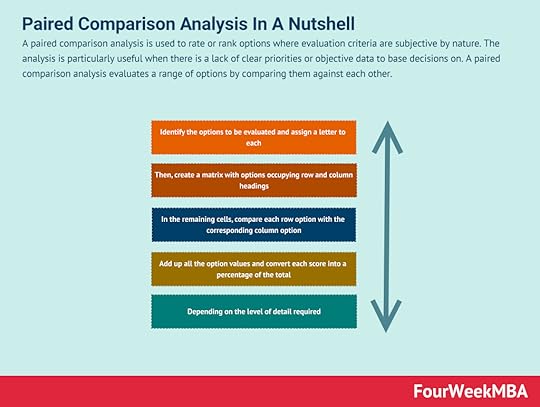 A paired comparison analysis is used to rate or rank options where evaluation criteria are subjective by nature. The analysis is particularly useful when there is a lack of clear priorities or objective data to base decisions on. A paired comparison analysis evaluates a range of options by comparing them against each other.
A paired comparison analysis is used to rate or rank options where evaluation criteria are subjective by nature. The analysis is particularly useful when there is a lack of clear priorities or objective data to base decisions on. A paired comparison analysis evaluates a range of options by comparing them against each other.Related Strategy Concepts: Go-To-Market Strategy, Marketing Strategy, Business Models, Tech Business Models, Jobs-To-Be Done, Design Thinking, Lean Startup Canvas, Value Chain, Value Proposition Canvas, Balanced Scorecard, Business Model Canvas, SWOT Analysis, Growth Hacking, Bundling, Unbundling, Bootstrapping, Venture Capital, Porter’s Five Forces, Porter’s Generic Strategies, Porter’s Five Forces, PESTEL Analysis, SWOT, Porter’s Diamond
Main Free Guides:
Business ModelsBusiness StrategyBusiness DevelopmentDigital Business ModelsDistribution ChannelsMarketing StrategyPlatform Business ModelsRevenue ModelsTech Business ModelsThe post Needs Vs. Wants In Marketing appeared first on FourWeekMBA.



